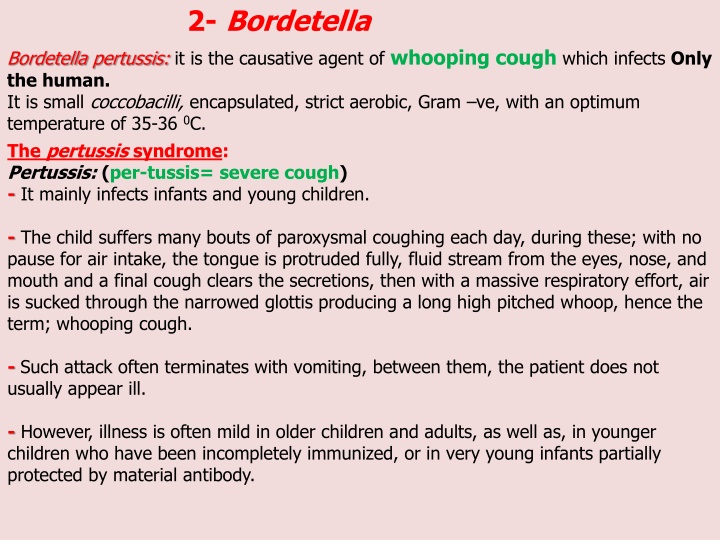
Bordetella Pertussis and Haemophilus: Causes and Symptoms
Learn about Bordetella pertussis, the causative agent of whooping cough that mainly affects infants and children. Explore its pathogenesis, laboratory diagnosis, and treatment. Discover Haemophilus, small Gram-negative rods in the human respiratory tract. Get insights into culture methods for Haemophilus identification.
Download Presentation

Please find below an Image/Link to download the presentation.
The content on the website is provided AS IS for your information and personal use only. It may not be sold, licensed, or shared on other websites without obtaining consent from the author. If you encounter any issues during the download, it is possible that the publisher has removed the file from their server.
You are allowed to download the files provided on this website for personal or commercial use, subject to the condition that they are used lawfully. All files are the property of their respective owners.
The content on the website is provided AS IS for your information and personal use only. It may not be sold, licensed, or shared on other websites without obtaining consent from the author.
E N D
Presentation Transcript
2- Bordetella Bordetella pertussis: it is the causative agent of whooping cough which infects Only the human. It is small coccobacilli, encapsulated, strict aerobic, Gram ve, with an optimum temperature of 35-36 0C. The pertussis syndrome: Pertussis: (per-tussis= severe cough) - It mainly infects infants and young children. - The child suffers many bouts of paroxysmal coughing each day, during these; with no pause for air intake, the tongue is protruded fully, fluid stream from the eyes, nose, and mouth and a final cough clears the secretions, then with a massive respiratory effort, air is sucked through the narrowed glottis producing a long high pitched whoop, hence the term; whooping cough. - Such attack often terminates with vomiting, between them, the patient does not usually appear ill. - However, illness is often mild in older children and adults, as well as, in younger children who have been incompletely immunized, or in very young infants partially protected by material antibody.
Pathogenesis: - The organism is transmitted by airborne droplets during the coughs. - The organism is attached to the ciliated epithelium of the upper respiratory tract, but do not invade the underlying tissues. - Decreased cilia activity followed by their death, are the main aspects of pathogenesis. - Several factors play a role in pathogenesis: 1- Presence of a filamentous haemagglutinin protein in their fimbriae for attachment on the epithelial cells. Presence of the specific antibody in the blood will prevent this attachment. 2- Pertusis toxin, this stimulates adenylate cyclase activity in a similar manner to that of cholera, which leads to rise in CAMP. This toxin also, leads to lymphocytosis in the blood (up to 70%) due to their failure to enter the lymphoid tissues. 3- Synthesis of adenylate cyclase enzymes which protect the bacterial cell from internal killing by phagocytic cells. Mutants lack this enzymes are considered a virulent. 4- Production of tracheal cytotoxin, which is a fragment of the bacterial peptidoglycan that damages ciliated cells of the respiratory tract. This toxin appears to act in combination with endotoxins to induce nitric oxide which kills ciliated epithelial cells.
Laboratory diagnosis: * Nasopharyngeal swab is taken during the paroxysmal stage * Direct fluorescent-antibody staining is used. * Bordet- Gengue medium (contains 20-30% blood) is used for isolation. * Polymerase chain reaction- based tests are highly specific and sensitive. Treatment: Erythromycin reduces the number of organism, but the toxin has already damaged the epithelial cells, therefore supportive care should be taken
Overview- Haemophilus Small Non-motile Gram-negative rods Transmitted via respiratory droplets, or direct contact with contaminated secretions Normal flora of the human respiratory tract and oral cavity.
Culture On chocolate agar, flat, grayish brown colonies with diameters of 1 2 mm are present after 24 hours of incubation. IsoVitaleX in media enhances growth. H influenzae does not grow on sheep blood agar except around colonies of staphylococci ("satellite phenomenon"). H haemolyticus and H parahaemolyticus are hemolytic variants of H influenzae and H parainfluenzae, respectively
Haemophilus species of clinical importance 1. H. influenzae -type b is an important human pathogen 2. H. ducreyi -sexually transmitted pathogen (chancroid) 3. Other Haemophilus are normal flora - H. parainfluenzae pneumonia & endocarditis - H. aphrophilus pneumonia & endocarditis - H. aegyptius pink eye (purulent conjunctivitis) or Brazilian Purpuric Fever
Differentiation of Species Growth Factor Hemolysis X Y H. influenzae - - - + - + + + - - + + - + - H. aegyptius H. ducreyi H. parainfluenzae H. aphrophilus
Pathogenesis: * H.influenzae infects Only human, there is No animal reservoir. It enters the body through the upper respiratory tract, resulting in either asymptomatic colonization or may cause infection such as sinusitis, otitis media or pneumonia. * The organism produces IgA protease that degrades the secretary IgA which facilitate its attachment to the respiratory mucosa. * Then organism enters the blood stream and reaches the meninges. * Pathogenesis involves the antiphagocytic capsule and endotoxins, no exotoxins are produced. * Most infections occur in children between the age s 6months-6 years, with a peak of 0.5-1year, due to decrease in maternal IgG, and inability of the child to form sufficient anticapsular antibodies until the age of 2 years.
Clinical findings: * Meningitis caused by H.influenzae cannot be differentiated from those caused by the other group of bacteria. * Symptoms include rapid onset of fever, headache, and stiff neck with drowsiness. * Infection may be accompanied with sinusitis and otitis media. * Unencapsulated strain can cause pneumonia in elderly adults, especially those with chronic respiratory disease. Laboratory diagnosis: 1- Organism should isolate on chocolate medium supplemented with factor X & V. 2- H.parainfluenzae does not require these two factors. 3- Further identification could be made by using Quelling reaction and fluorescent antibody technique or other immunological techniques. Treatment: The drug of choice is ceftriaxone, because 20-30% of H.influenzae produce lactamase.






















